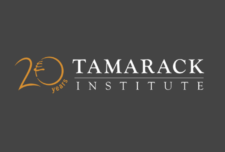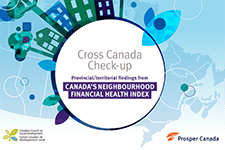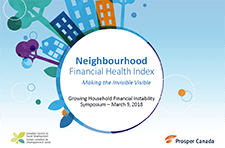Discover financial empowerment resources
Discover financial empowerment resources
Poverty stems from experiences of exclusion and isolation in addition to a lack of financial resources, especially for equity deserving members of society. When individuals feel disconnected and undervalued, it can lead to a cycle of poverty that can be further perpetuated by race, ethnicity,...

This report examines the financial health and vulnerability of households in Canada’s 35 largest cities, using a new composite index of household financial health at the neighbourhood level, the Neighbourhood Financial Health Index or NFHI. The NFHI is designed to shine a light on the dynamics...

Canada ranks consistently as one of the best places to live in the world and one of the wealthiest. When it comes to looking at the financial health of Canadian households, however, we are often forced to rely on incomplete measures, like income alone, or aggregate national statistics that tell us...

In this video presentation Katherine Scott from the Canadian Council on Social Development (CCSD) shares the new Neighbourhood Financial Health Index, a mapping tool which uses composite data about income, assets, debt, and poverty to show levels of financial health at the neighbourhood...

This brief and an accompanying interactive map were commissioned by the New York City Department of Consumer Affairs’ Office of Financial Empowerment. The brief provides information on how many New Yorkers are unbanked and underbanked, recognizing their links to financial health. It also...
This overview paper broadly outlines the types of strategies being used to help people move up from poverty. It lays out basic categories for classifying such programs, explains the logic of various approaches, and offers some broad pros and cons of various types of interventions. The accompanying...
The following profile presents data on the economic inequalities within Miami. These statistics may seem overwhelming. However, we with more information about the challenges of racial economic inequality, there is greater opportunity to identify best practices and policies that can address the...
The following profile presents data on the economic inequalities within New Orleans. These statistics may seem overwhelming. However, we know with more information about the challenges of racial economic inequality, there is greater opportunity to identify best practices and policies that can...
There is much evidence that the quality of the social determinants of health Canadians experience helps explain the wide health inequalities that exist among Canadians. How long Canadians can expect to live and whether they will experience cardiovascular disease or adult-onset diabetes is very much...
This report explores New Zealand’s ‘Bright Spots’ – local places and community initiatives that are making a positive difference to children and families. Instead of asking about the issues and problems for ‘vulnerable children’ or ‘high-needs families’, we ask ‘what’s...
According to the U.S. Department of Labor, there are 20 million youth ages 16 to 24 participating in the American workforce, many of them in municipal workforce and employment programs. While some of these local programs offer financial education workshops, many young workforce program participants...
Toronto is facing a big problem. As access to opportunity is increasingly out of reach for too many that live here, the reputation of “Toronto the Good” is being compromised. Because of the concentration of poverty, declining job quality and rising income inequality, we are seeing that Toronto...
Using data gathered from the previous three censuses (2011, 2006, 2001) United Way/Centraide Windsor-Essex County, in partnership with the Great Lakes Institute of Environmental Research (GLIER), has mapped a number of the socio-economic indicators that have shaped Windsor and Essex County. Over...
The rise of economic inequality has become a staple of policy debates and stump speeches. Less visible is the way the rise has altered the landscape of America’s urban neighborhoods. Two books should help change that. Matthew Desmond, an urban sociologist at Harvard, has delivered a jolt with...
This review looks at the activities, impact, and drivers and barriers to success of four types of community-led approaches: voluntary action, community organising, social action and community economic...
In this report we use a set of indicators that measure health risks, health care and health outcomes, and through these indicators we see the link between income and health – how income impacts health, and how health impacts income. The results reveal a tremendous opportunity to make life better...
Alcohol overuse and poverty, each associated with premature death, often exist within disadvantaged neighbourhoods. Cheque cashing places (CCPs) may be opportunistically placed in disadvantaged neighbourhoods, where customers abound. This article explores whether neighbourhood density of CCPs and...
Spanning over four decades, the Panel Study of Income Dynamics (PSID) is the world’s longest-running household panel survey. The resulting data archive presents research opportunities for breakthroughs in understanding the connections between economic status, health and well-being across...
Canadian households are now deeper in debt than at any time since Statistics Canada began collecting debtor data in 1961. Debt, payment delinquency, and bankruptcy are increasingly a part of the lives of the young, the socioeconomically marginalized, and renters. This In-Brief explores the...
To better understand the financial state of U.S. households, the Federal Reserve Board conducted a new consumer survey, the results of which are described in this report. The Survey of Household Economics and Decision-making (SHED) was conducted by the Board’s Division of Consumer and Community...
The challenges that credit invisibles and consumers with unscored records face in accessing credit markets has generated considerable attention from researchers and industry participants. Despite all of this attention, very little is known about the number or characteristics of credit invisibles...
This is the slide deck for the CFED-hosted webinar "Programs, Policies, Partnerships: Coming Together to Heal the Racial Wealth...
This is the Summer 2016 issue of OnPolicy, put out by the CCPA Ontario. This issue includes articles on working poverty by neighbourhood, food insecurity, academic work and employment precarity, and...
